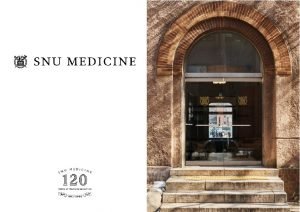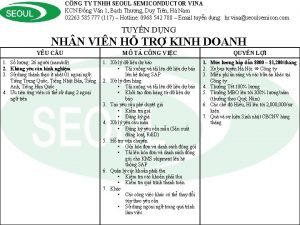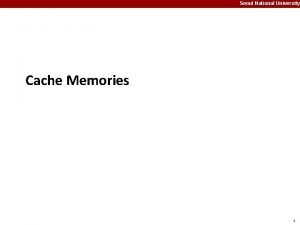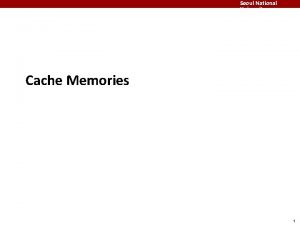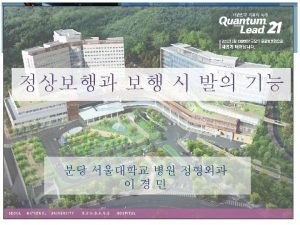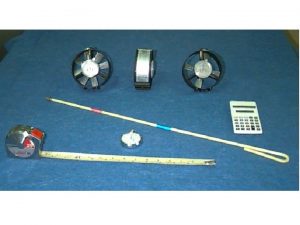Surgical Plan Solution for Deformity Correction Seoul National






![Process #4 (1/2) � [FVDO] Movement Research Lab. SNU 6/8 Process #4 (1/2) � [FVDO] Movement Research Lab. SNU 6/8](https://slidetodoc.com/presentation_image_h/cf7c22839bc26ef56984f010ab07c3df/image-7.jpg)




- Slides: 11

Surgical Plan Solution for Deformity Correction Seoul National University Movement Research Lab. Seoul National University Bundang Hospital 2013. 4. 6 Jiwon Jeong

Motivation (1/2) � Find the best surgical plan and minimization of unexpected side effects � Focus on the surgery which cause transformation of bone geometry � Care about the complex side effects of single-stage multi-level surgery Personal Data (X-Ray) Automatic 3 D Reconstruction • Lower limb bone (Femur, Tibia) • 3 D mesh model Manual Simulation • By person • Using simulator Automatic Simulation • By simulator • Need policy Movement Research Lab. SNU Find Best Solution • Variables (position, angle, wedge, etc. ) Perform Surgery 1/8

Motivation (2/2) � What is an important criterion when developing the surgical plan? � Clinical measurements (neck-shaft angle, femoral version, shaft bowing etc. ) � Lower limb alignment (mechanical axis, anatomical axis, etc. ) [Clinical measurements] Movement Research Lab. SNU [Lower limb alignment] 2/8

Approach � Full Process � 3 D reconstruction of lower limb using X-ray images (2 biplanar X-ray images) � Find the feature points in lower limb using 3 D geometry model � Calculate the parameters which are related with lower limb posture � Find the best surgical plan (below is an example of FVDO) � Input : patient’s current posture (feature points and parameters pair) predefined ideal posture (parameters) � Output : wedge angle, cutting position, rotation angle and expected posture � Processing : minimization of error between patient’s posture and ideal posture Movement Research Lab. SNU 3/8

Process #1 � 3 D Reconstruction of lower limb using X-ray images � Input : 2 biplanar X-ray images � Output : 3 D geometry model of femur and tibia � Development approach � Femur : already done (be sure to check it is working accurately to abnormal bone) � Tibia : development approach is as same as femur reconstruction [Process of femur reconstruction] Movement Research Lab. SNU 4/8

Process #2 & #3 � Find the feature points of lower limb using 3 D geometry model � Using vertex level processing, find the feature points � Calculate the parameters which are related with lower limb posture � Using the feature points, calculate the axes, planes, and parameters Parameters Neck-shaft angle Femoral version Hip-knee-ankle angle Condylar-tibia angle Mechanical axis deviation [Lower limb feature points & axes example] Movement Research Lab. SNU [Parameters example] 5/8
![Process 4 12 FVDO Movement Research Lab SNU 68 Process #4 (1/2) � [FVDO] Movement Research Lab. SNU 6/8](https://slidetodoc.com/presentation_image_h/cf7c22839bc26ef56984f010ab07c3df/image-7.jpg)
Process #4 (1/2) � [FVDO] Movement Research Lab. SNU 6/8

Process #4 (2/2) � Movement Research Lab. SNU 7/8

Action Plan � Set the feature points and parameters � Define important parameters for surgical plan or lower limb posture � Define axes, planes, and points for calculation of parameters � Formulation � Tibia reconstruction � Make a training set for tibia reconstruction � Check the accuracy of femur reconstruction solution for an abnormal bone � Develop a tibia reconstruction Movement Research Lab. SNU 8/8


Thank you
 The illusion of life
The illusion of life Seoul national university computer science
Seoul national university computer science Seoul national university college of medicine
Seoul national university college of medicine Seoul national university events
Seoul national university events Seoul metal vietnam
Seoul metal vietnam The seoul accord agreement accredits
The seoul accord agreement accredits Seoul metro map
Seoul metro map Undergraduate graduate postgraduate
Undergraduate graduate postgraduate Công ty seoul semiconductor vina
Công ty seoul semiconductor vina Seoul
Seoul Seoul semiconductor vina
Seoul semiconductor vina Seoul
Seoul


